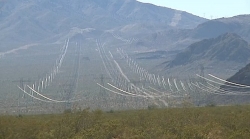
Originally posted July 27, 2013 on San Diego Loves Green
By Roy L. Hales
I recently asked one of San Diego’s better known engineers, Bill Powers, a number of questions about the Sunrise Powerlink and rooftop solar energy. These are his answers.
1. Can San Diego replace all the energy scheduled to come down the Sunrise Powerlink with energy generated from solar panels on rooftops, parking lots and brownfield areas?
 Bill – Yes. San Diego County urban and suburban developed areas have about 7,000 MW of rooftop and parking lot solar capacity. So far about 150 MW of this capacity has been developed, about 2%. The capacity of Sunrise Powerlink is 1,000 MW.
Bill – Yes. San Diego County urban and suburban developed areas have about 7,000 MW of rooftop and parking lot solar capacity. So far about 150 MW of this capacity has been developed, about 2%. The capacity of Sunrise Powerlink is 1,000 MW.
2. Do you think the day is coming when California will be able to generate 100% of its energy needs from solar panels on rooftops, parking lots and brownfield areas?
Bill – Yes and no. California already generates lots of renewable energy from geothermal, wind, remote utility-scale solar, biomass, and small hydro. We will continue to use these existing resources along with solar on rooftops, parking lots and brownfield areas. However, going forward solar on rooftops, parking lots and brownfield areas should be our primary focus for economic and environmental reasons.
3. How distant do you think that time is?
Bill – We could readily be 100% renewable for electricity needs by 2030.
4. What proportion of San Diego’s rooftops, parking lots and brownfield areas would we need to cover with solar panels in order to generate enough power to meet the city’s needs?
Bill – We would need to develop about half to two-thirds of the 7,000 MW potential to meet all of the City of San Diego’s electricity needs with solar on rooftops, parking lots and brownfield areas.
5. Is rooftop solar being used as a primary energy source anywhere in the world?
Bill – Germany.
6. Do you have any statistics that compare the production costs of rooftop solar vs energy transmitted from industrial scale solar farms via systems like the Sunrise Powerlink?
Bill – The cost of production of PV in Imperial County is somewhat lower than the cost of production on a rooftop in San Diego. However, if you factor-in the cost of the transmission line to get the Imperial Valley solar to San Diego, and the cost of back-up gas turbines built in San Diego for emergency situations when Imperial Valley solar cannot get to San Diego, then local rooftop solar is substantially less costly in aggregate.
7. Do you have any idea how much of the energy carried by Sunrise Powerlink is lost in transmission?
Bill – About 7-8% on average, and about 14% on hot summer afternoons when demand is high and the transmission line is heavily loaded.
 8. Can we effectively eliminate that power loss using rooftop solar?
8. Can we effectively eliminate that power loss using rooftop solar?
Bill – Yes.
9. One of the criticisms sometimes leveled at Utilities companies like SDG&E is that they are “top heavy,” they pay their company officers and high ranking executives too much. Is this a valid criticism? How much are they paying their officers and top executives? What proportion of SDG&E’s total expenses does this represent? And would SDG&E be able to get people of the same caliber for less money?
Bill – Don’t know their salaries. The City of San Diego is studying taking over the electricity supply function of SDG&E through the Community Choice Aggregation law. Marin County has already gone this route. CCA employees would not be paid excessive salaries.
10. Is there any reason we should not use the Sunrise Powerlink, now that it is operational?
Bill – No.
11. What would it cost to dismantle the Sunrise Powerlink? and who would pay that cost?
Bill – I do not know the cost of dismantling. Utility customers would pay.
(Photo at top of Page: A crew from SolarCity at work – SolarCity)







Recent comments